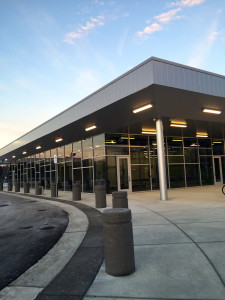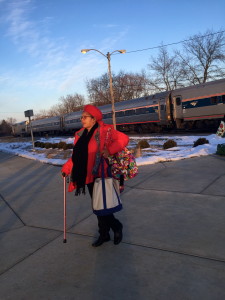
The new Amtrak station in East Lansing, Michigan
Sunday morning passengers are lining up in East Lansing, Michigan to board the Blue Water train heading to Chicago. It arrives 10 minutes early but waits until its 8:45am departure time. Like many train routes this one has a segment alongside a river. I see a ferryboat frozen in the water. It reminds me of while working at the Illinois Central Gulf railroad. We hired photographers to take aerial shots from a helicopter whenever barges were frozen in the Mississippi River. Not far from the river’s banks would be an ICG freight train rolling on its tracks. The newswire services would distribute the dramatic photos of the stuck barges to newspapers and television stations in big and small cities. The idea of course was to show the resilience of rail transportation.
The view on the Blue Water train is of ice fishing tents scattered across frozen lakes. I see a herd of deer trotting in the snow along a creek bed. Cemeteries on rolling hills give way to grain silos. The W post tells the engineer to blow the train’s whistle as it approaches a grade crossing. Seconds later I hear the whistle sounding like a whale wailing. Perhaps the cold is morphing its sound. Outside the rows of dormant crops are sheep, cows and horses grazing in snow-covered pastures. At times like this I love being a solo traveler.
Then I see him. One of the speakers at a conference I just attended is seated a few rows up from me. I casually walk down the aisle, stop, and ask him if he is who I think he is.
“Yes, that’s me.” He’s kind of excited that someone on the train recognizes him. I explain who I am – a writer curious about why people take the train.
“Do you mind if I ask you a few questions?” He puts down his phone and moves two books from his lap. I have his attention.Continue reading

